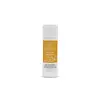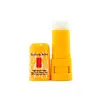What's inside
What's inside
 Key Ingredients
Key Ingredients

 Benefits
Benefits

No benefits
 Concerns
Concerns

 Ingredients Side-by-side
Ingredients Side-by-side

Simmondsia Chinensis Seed Oil
EmollientCocoglycerides
EmollientCera Alba
EmollientRicinus Communis Seed Oil
MaskingCaprylic/Capric Triglyceride
MaskingRhus Verniciflua Peel Cera
EmollientHelianthus Annuus Seed Cera
EmollientButyl Methoxydibenzoylmethane
UV AbsorberEthylhexyl Salicylate
UV AbsorberEthylhexyl Triazone
UV AbsorberBis-Ethylhexyloxyphenol Methoxyphenyl Triazine
Skin ConditioningTitanium Dioxide
Cosmetic ColorantVanillin
MaskingSilica
AbrasiveTocopherol
AntioxidantAscorbyl Palmitate
AntioxidantDimethicone
EmollientLecithin
EmollientGlyceryl Stearate
EmollientGlyceryl Oleate
EmollientCitric Acid
BufferingSimmondsia Chinensis Seed Oil, Cocoglycerides, Cera Alba, Ricinus Communis Seed Oil, Caprylic/Capric Triglyceride, Rhus Verniciflua Peel Cera, Helianthus Annuus Seed Cera, Butyl Methoxydibenzoylmethane, Ethylhexyl Salicylate, Ethylhexyl Triazone, Bis-Ethylhexyloxyphenol Methoxyphenyl Triazine, Titanium Dioxide, Vanillin, Silica, Tocopherol, Ascorbyl Palmitate, Dimethicone, Lecithin, Glyceryl Stearate, Glyceryl Oleate, Citric Acid
Ingredients Explained
These ingredients are found in both products.
Ingredients higher up in an ingredient list are typically present in a larger amount.
Also known as Avobenzone, this ingredient is a chemical sunscreen filter that provides protection in the UV-A range.
Avobenzone is globally approved and is the most commonly used UV-A filter in the world.
Studies have found that avobenzone becomes ineffective when exposed to UV light (it is not photostable; meaning that it breaks down in sunlight). Because of this, formulations that include avobenzone will usually contain stabilizers such as octocrylene.
However, some modern formulations (looking at you, EU!) are able to stabilize avobenzone by coating the molecules.
Avobenzone does not protect against the UV-B range, so it's important to check that the sunscreen you're using contains other UV filters that do!
The highest concentration of avobenzone permitted is 3% in the US, and 5% in the EU.
Learn more about Butyl Methoxydibenzoylmethane